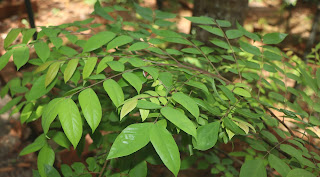556
Averrhoa carambola L.
Synonym
|
:
|
Averrhoa
acutangula
|
Family
|
:
|
Oxalidaceae
|
Local name
|
:
|
English - Chathurapuli, Karambola
Malayalam - Star fruit
tree, Carambola apple
|
Flowering and fruiting period
|
:
|
May-August
|
Distribution
|
:
|
Native of
Indonesia, cultivated in other Tropical countries
|
Distribution in Kerala
|
:
|
All
Districts
|
Habitat
|
:
|
Cultivated
|
Endemic/Exotic
|
:
|
Exotic
|
Uses
|
:
|
The fruit acts as a laxative and is used in
traditional medicine against fever, skin disorders, high blood pressure, and
diabetes. The leaves, on the other hand, are used as relief from rheumatism;
the flowers against coughs, and the seed against asthma, colic, and jaundice.
|
Key
Botanical Characters:
Tree, up to
15 m tall; branches often drooping; young parts yellowish-pubescent to
reddish-glabrescent. Leaves scattered; rachises to 20 cm long; leaflets 3-6
pairs, variable, acute to acuminate at apex. Inflorescences axillary, rarely
on branches, to 6 cm long; pedicels 3-6 mm long; jointed above middle. Sepals
obovate or oblong-ovate to 3-angled, acute to obliquely emarginate, subglabrous,
bright red, yellowish brown with pale margin when dry. Petals obovate to
lanceolate, connate above 1 mm long claw, glabrous or with minute
septate-glandular hairs inside. Shorter stamens without anthers; filaments
often swollen at base. Ovary ellipsoid, appressed-puberulous mainly on ribs;
ovules 3-5 in each locule; styles to 2 mm long. Fruits ovoid to ellipsoid
with 5 acute longitudinal ridges, stellate in cross section, lobed at both
ends, to 12 x 6 cm, shining, yellowish green; seeds to 10, 12 x 5 mm; aril
2-lipped, enclosing seed, fleshy.
|
||

